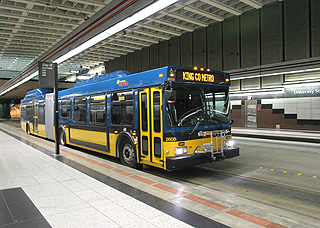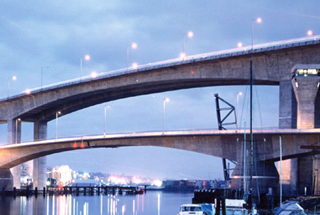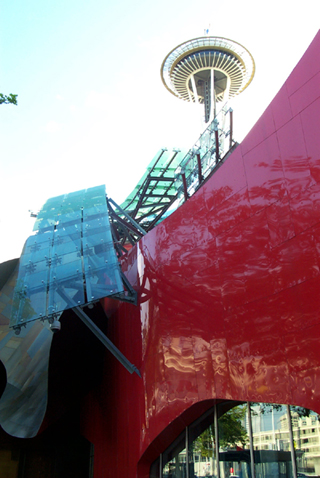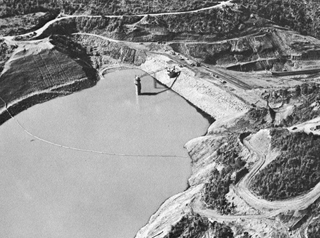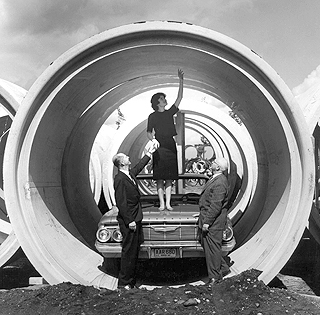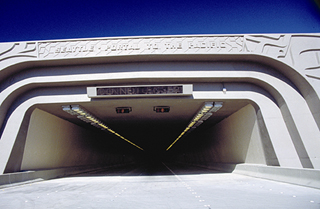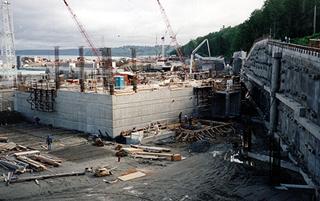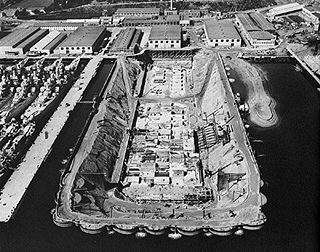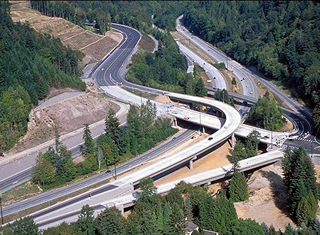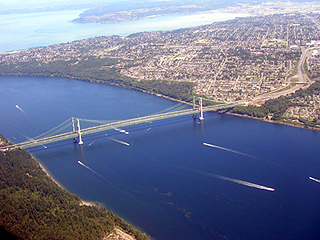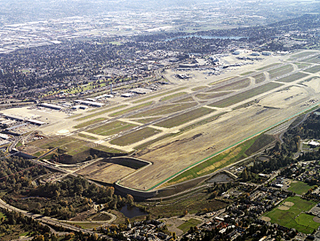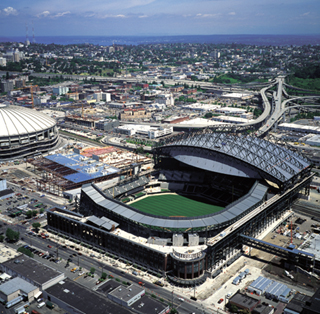
DJC.COM
September 12, 2007
ACEC members pick the best of 50 years
Since its inception, the American Council of Engineering Companies of Washington and its members have had a remarkable impact on our built environment.
From environmental clean up and developing energy-saving technology to massive transportation infrastructure and structural systems that support high-rise towers, the engineering profession has designed thousands of projects that have made peoples’ lives safer and better.
Fifty years ago, sewage was spewing into Elliott Bay, the shore at West Point below Discovery Park was covered with murky sewage residue and emitted a constant stench, and Lake Washington was so polluted swimming was banned.
Those environmental challenges, whose cleanup was enhanced by a regional sewage study published by Brown and Caldwell in 1958, led to the establishment of the Municipality of Metropolitan Seattle or Metro. Initially charged with sewage treatment and water quality issues, it was later authorized by the voters to expand into transportation. Simultaneously, civic pride, a growing economy and population gave rise to many private projects that both showcase remarkable engineering accomplishments and point to continuing advances for years to come.
ACEC Washington members nominated the following projects as some of the most significant of the past 50 years. Images courtesy of ACEC
Downtown Seattle transit tunnel (1984—90)
The downtown Seattle transit tunnel is an innovative 1.6-mile-long bus/rail tunnel that includes five stations (three underground and two above ground). It has twin 21-foot-diameter bored tubes that carry dual-propulsion buses operating on electricity in the tunnel and diesel on the streets.
PB (formerly Parsons Brinkerhoff) designed the tunnel to accommodate light-rail vehicles, which will start using it in 2009. The project required protection of existing major public buildings while adjacent tunneling and street excavation was taking place in the heart of the city. Innovative construction phasing for tunneling and station excavation were implemented to mitigate construction impacts to the central business district.
The tunnel includes more than $1.5 million in artwork. The project has won many national awards and remains a triumph of the marriage of art, architecture and engineering.
West Seattle high- and low-level bridges (1980s)
The West Seattle high-level and low-level bridges were built in the 1980s to replace a bascule bridge that was damaged by a freighter in the Duwamish Waterway. The replacement bridges were urgently needed to reconnect West Seattle to the city and major north-south highways.
PB (formerly Parsons Brinkerhoff) designed the state-of-the-art concrete bridges with both aesthetics and local seismic conditions in mind. Theses bridges are the primary corridor for 60,000 vehicles per day from West Seattle to the industrial area and downtown Seattle. The structures are one of the primary freight corridors from the Port of Seattle’s terminals 5 and 18 to I-5 and I-90.
The mile-long high-level bridge was built as the first phase 140 feet above the Duwamish Waterway. The second phase was a low-level bridge that resulted in the world’s largest concrete swing bridge. Both structures won many national and international awards for engineering excellence. They will remain critically important to the city of Seattle and the industrial area well into the future.
Experience Music Project (2000)
Magnusson Klemencic Associates with architects Frank O. Gehry & Associates and LMN designed the unique Experience Music Project.
Whether you love it or hate it, there’s no denying that the free-form swoops and curves of Paul Allen’s 140,000-square-foot interactive music museum define a new standard of creativity and advanced design. The development of an entirely new structural system and the creation of the project in total 3-D, put EMP at the forefront of engineering technology.
Gehry began design by determining position on the site and the basic spatial and functional concepts. Then, starting with sketched visions and proceeding to carefully crafted hand-built models, Gehry’s office created the look and feel of EMP. Once satisfied, a digitizing tool captured the model’s geometric coordinates into sophisticated 3-D software. Visually refined, it now remained to figure out how the structure could be built!
While Gehry’s Bilbao Guggenheim project looks similar to EMP, it is comprised primarily of ruled surfaces. This means that the structures can be framed conventionally with straight members and the skin warped to fit the design intent. EMP’s constantly changing curvature in all directions prevented this approach. Yet the project’s success rested on the development of a structural system with a defined load path that was able to adapt to the curves, span long distances, resist earthquakes, and, of course, be constructible.
This new structural system has 240 individually curving steel beams covered by mesh then a 5-inch layer of shotcrete over welded wire fabric. This creates each major gallery element as a steel-stiffened concrete shell, with the shell resisting earthquake forces while it is held in place, shaped and stiffened by the steel ribs. The entire structure was then coated with a waterproof membrane. An elaborate system of 5-inch-diameter steel pedestals of varying lengths attached to the ribs was devised to support 3,000 panels made of steel and aluminum.
Many innovative techniques were used into the design of EMP, including:
• A steel-stiffened concrete shell. The structural system took its cue from the ribbed construction of airplanes and boats, then applied the idea for the first time to a building. By designing each rib with a different geometry, the desired curves and swoops could be captured in place.
• The most advanced application of computer technology ever to the entire design and construction process. Everything — starting with initial design and continuing through construction — was accomplished using one common database. While buildings have previously been designed in 3-D, never before has the approach been used in such detail to actually construct a building.
• A steel-stiffened shell that translated to the first free-form building. EMP is unlike any structure ever designed — including others by Frank Gehry — in that the building is a total free-form shape. At any point on the surface of EMP, non-symmetrical curvature occurs in ALL directions.
• Engineering that revisited and modified every aspect of design. While some projects require the development of a single new method or technique, EMP demanded that every single aspect of its structure be invented. This included how the structure was analyzed and designed, how it was shown on the drawings, how it was detailed, how it was erected, and how the concrete was formed, placed and finished.
Seattle water supply (1980)
Tetra Tech/KCM has long been involved in the development of Seattle’s water supply, beginning with the Tolt River Dam and pipeline, which began transporting water to Seattle and the Eastside in 1963.
In 1980, the firm prepared the Seattle Metropolitan Water Supply Study, the first generation of modern water system planning documents introducing concepts such as hydraulic computer modeling and working with regulatory agencies to create new approaches for water quality protection and conservation.
In 2005, Tetra Tech/KCM finished work on Lincoln Reservoir at Cal Anderson Park, the first of the city’s major reservoir burying projects, which allowed creation of a revitalized urban park on Capital Hill. The Berger Partnership, paying tribute to the original Olmsted design, designed the park.
Cleaning up Lake Washington and Puget Sound (1958—78)
Between 1958 and 1978, a four-firm joint venture called Metro Engineers — involving KCM (now Tetra Tech), R.W. Beck, Brown and Caldwell, and Hill, Ingman, Chase & Co. (now URS) — became the engineering powerhouse for the newly formed political body, the Municipality of Metropolitan Seattle.
Metro Engineers designed King County’s modern sewage collection and treatment system, including six of the area’s first large soft-ground tunnels, 25 miles of huge trunk sewers, 18 pump stations, and the Renton and West Point treatment plants — all of which remain the foundation of our sanitary engineering and water quality protection apparatus today.
I-90 Mount Baker Ridge tunnels (1979—89)
This project was awarded ACEC’s highest achievement, the Grand Conceptor Award in 1987.
HNTB was Washington State Department of Transportation’s prime consultant to design the 63-foot-diameter, 1,500-foot-long bored tunnel, the largest diameter soft-soil tunnel in the world at that time. The project involved building a soft-earth bore tunnel through Mt. Baker Ridge as well as 1,900 feet of additional cut-and-cover tunnel in Rainier Valley. The Rainier Valley tunnel was designed to re-connect the community that had been divided by the highway that was being expanded to eight lanes.
The “stacked-drift” design allowed the use of conventional 8- to 10-foot-diameter tunnel excavation equipment rather than a single, large-diameter tunnel-boring machine. Less surface area was exposed at a time and the drift was immediately filled with concrete so the potential magnitude of ground disturbance was minimized. The drifts were placed in a large circle with a 63-foot-diameter that formed the liner for the final tunnel.
West of the tunnel, the roadway is in the Seattle lid, which carries three lanes of westbound traffic on a 54-foot-wide roadway and a 40-foot-wide, two-lane transit/carpool roadway. The roadways are stacked through the tunnel using a cast-in-place rigid framed structure supported on the tunnel liner. Above the westbound roadway ceiling, a 15-foot-wide pedestrian/bicycle lane is provided.
In addition, HNTB designed the eastbound roadway that included refurbishing the SR-10 twin tunnels under Mt. Baker Ridge and connecting them to a cut-and-cover lid to the west.
West Point Wastewater Treatment Plant (1962-96)
Between 1962 and 1966, Metro built the West Point treatment plant, a huge leap forward in technology that eliminated the direct discharge of millions of gallons of raw sewage into the Duwamish River and Elliott Bay. Cost of construction was $11.9 million.
Despite controversy over its Discovery Park location, between 1991 and 1996 West Point was expanded and converted to secondary level treatment to comply with new federal regulations.
CH2M Hill was the lead consulting firm with KCM providing structural engineering. Total cost of the 144 million-gallon-per-day secondary expansion was $573 million.
James R. Ellis, in a 1966 dedication speech, said: “For many, however, the clearest satisfaction lies in proving the compatibility of an urban community with its natural setting. Ten years is a short day in the life of a great city. We are transients on these hills and shores and the waters are not ours to spend. Ten years ago the urban drainage basins of the nation were heavily polluted. Today most of these waters have gone from bad to worse — but not here. Today most of the nation’s press are looking for scapegoats — but not here. Today most local councils are still waiting for someone else to do it — but not here. Here we dedicate substantial completion of the largest single pollution abatement project ever undertaken. Here we watch a welcome turning point in the story of our lakes and rivers and inland sea. Here we mark some proof that urban man can live and work in a beautiful land without destroying beauty.”
Drydock No. 6 at Bremerton Naval Shipyard (1960s)
With supreme confidence and salesmanship, Harrison Kramer convinced the Navy to hire KCM to design the landmark Drydock No. 6 at the Puget Sound Naval Shipyard. Completed in 1962 and the largest dock of its type at the time, it could hold the new giant Forrestal-class aircraft carriers at 1,200 feet long, 180 feet wide and 61 feet deep. KCM was co-designer of the project with the New York City firm of Moran, Proctor, Mueser and Rutledge.
In 2005, KPFF was engaged by the Navy to design a $10 million rehabilitation of the facility floor to continue its long service history.
I-90 from Snoqualmie Pass to I-5 (1974-2003)
I-90 is the state’s primary freight corridor between Western and Eastern Washington, as well as points farther east. This corridor contains two major floating bridges that are more than a mile long and large lidded structures and tunnels.
PB (formerly Parsons Brinkerhoff) designed and constructed significant structures through Snoqualmie Pass to increase capacity and safety, especially during the winter. In addition, several key interchanges found in Issaquah, I-405, Mercer Island and Seattle at I-5 include some of the largest curved steel structures in the state. The interchange on Mercer Island was unique because the ramps go under the freeway rather than over it, which is the method traditionally used. The Mercer Island section also won a rare U.S. Presidential award for design.
The I-90 tunnel through Mount Baker Ridge was the world’s largest in diameter when it was constructed. It contained multiple small-bore tunnels stacked upon each other to provide a three-level tunnel to Seattle.
The terminus of I-90 at I-5 is the most complex interchange in the state. It handles several hundred thousand vehicles per day and ends at two major sports stadiums.
The I-90 corridor will remain one of the most significant arteries in the state for the foreseeable future and is scheduled to accommodate a light-rail line in the future.
New Tacoma Narrows Bridge (2007)
The new Tacoma Narrows Bridge was designed and constructed parallel to and south of the 1950-vintage Narrows Bridge to relieve traffic on part of the state Route 16 corridor that links the Seattle-Tacoma metropolitan area and the Olympic Peninsula. The new suspension bridge is 5,413 feet long and 78 feet wide, with a 2,800-foot main span and two 510-foot-tall towers. It opened July 15, 2007.
HNTB and joint venture partner Parsons Transportation Group were selected by Tacoma Narrows Constructors (a joint venture of Bechtel and Kiewit) as the engineering team for the $849 million design-build project owned by the Washington State Department of Transportation.
The project has spanned almost 15 years and HNTB has been involved in every major phase, including: environmental and preliminary engineering; traffic and toll planning and design; final design; seismic and wind upgrade; deck and bridge rail retrofit; civil, architectural and landscape planning and design; engineering support during construction; and ongoing seismic retrofit of the existing bridge and interchanges.
Noteworthy aspects of the project include:
• It was designed with concrete towers instead of steel, which saved millions of dollars in material and labor costs.
• An innovative and economical foundation system with deep-water cast concrete caisson foundations located in environmentally sensitive waters was used. The caissons were installed without disrupting the remains of Galloping Gertie, the first bridge that collapsed and sank in 1940.
• The new bridge design was based on survivability criteria and a historical approach to withstand local seismic activity. Non-linear time-history seismic analysis used HNTB’s in-house T187 program and ADINA finite element program.
• Roadside restoration maintained the existing corridor continuity of both semi-urban and rural roadside classifications. Also, landscape architects successfully relocated War Memorial Park.
Third Runway, Sea-Tac Airport (2000—present)
Seattle-Tacoma International Airport, owned and operated by the Port of Seattle, is building a new parallel runway. The third runway will allow landings on two runways at the same time in all but the worst weather, reducing delays and providing greater efficiency during poor weather, which occurs about 44 percent of the time.
The impact of expanding the airfield next to sensitive areas was minimized by engineering the tallest mechanically stabilized earth wall in North America to contain the 16 million yards of fill material required for the runway base.
By reducing delays, the third runway is expected to help airlines save on fuel and personnel costs and help travelers save on hotels, meals and other expenses associated with delayed flights. Delays cost airlines and travelers millions of dollars each year.
Primary consultant HNTB has been involved in planning, preliminary engineering, permit support, design, program management and construction services since 1993.
Safeco Field (1999)
Structural engineer Magnusson Klemencic Associates worked with architect NBBJ to design a state-of-the-art outdoor ballpark so the Mariners baseball club could generate revenues needed to stay in Seattle. But in sometimes-rainy Seattle they needed an umbrella. The solution was a one-of-a-kind, world-class, retractable-roof 47,000-seat ballpark.
The 8.8-acre, 24 million-pound roof is comprised of three moving panels and can open or close in 10 minutes. The two end panels fit under the wider center panel. Arched, 50-foot-deep, triangular-shaped steel trusses support the panels. The bottom of the center panel is 219 feet above the field, a height dictated by studies of home run trajectories.
The panels sit on steel legs, 100 feet tall on the north side and 50 feet tall on the south. At the base of the legs are 16 travel trucks with individual wheel loads as high as 230,000 pounds. These wheels roll on an 800-foot-long, 100-foot-tall (50 feet on the north) trestle. The entire roof rolls along the runways and parks in a stacked position over adjacent railroad tracks, completely off the field. When parked in this location, the roof casts no shadows on the field during game time and allows virtually every seat in the ballpark to have open sky overhead, as well as magnificent views of downtown Seattle, Puget Sound and the Olympic Mountains.
The challenge of inventing a new type of structure under an incredibly tight schedule in difficult soil, wind, earthquake and snow conditions demanded the creation of many new structural ideas, several of which were world firsts. A few include:
• First retractable roof in the world with “walls” that retract with the roof (while other retractable-roof stadiums tend to operate like sunroofs for a closed building, Safeco is a true convertible).
• First fully retractable roof using linear tracking with independent roof panels (the linear tracking and independent panel design allows the roof to be fully stacked and provides a simpler method of dealing with temperature expansion and seismic displacement).
• In an application never before attempted, variable-depth, variable-width, triangular (tri-chord) trusses were developed to support the roof while making a dramatic architectural statement and reducing costs.
• New use of structural shock absorbers (Safeco Field has the world’s largest energy dampers ever used in a building application and the first-ever use of its type in any structure).
Other Stories:
- A beautiful tomorrow for structural engineering?
- 7 Engineering Wonders: Structural — How to keep it all working after the BIG ONE
- Infrastructure: out of sight, out of mind?
- Engineering a sea change at the aquarium
- ACEC says ‘yes’ to roads and ‘no’ to lawsuits
- Engineers, architects join forces on public policy
- Is our engineering rank slipping in the world?
- 7 Engineering Wonders: Electrical/Communications — Engineering a hospital to save lives
- 7 Engineering Wonders: Mechanical — EMP: an experience unlike any other
- 7 Engineering Wonders: Environmental — Brightwater planning raises awareness, not eyebrows
- 7 Engineering Wonders: Transportation/Infrastructure — Tunnels keep traffic flowing out of sight
- 7 Engineering Wonders: Civil — Making the grade for a road separation
- 7 Engineering Wonders: Geotechnical — A firm foundation for the new Narrows Bridge
- Geotechnical engineering gets a tech boost
- Finding workers may be engineering’s biggest challenge
- What a difference 50 years make
- What makes engineers tick?
Copyright ©2009 Seattle Daily Journal and DJC.COM.
Comments? Questions? Contact us.
